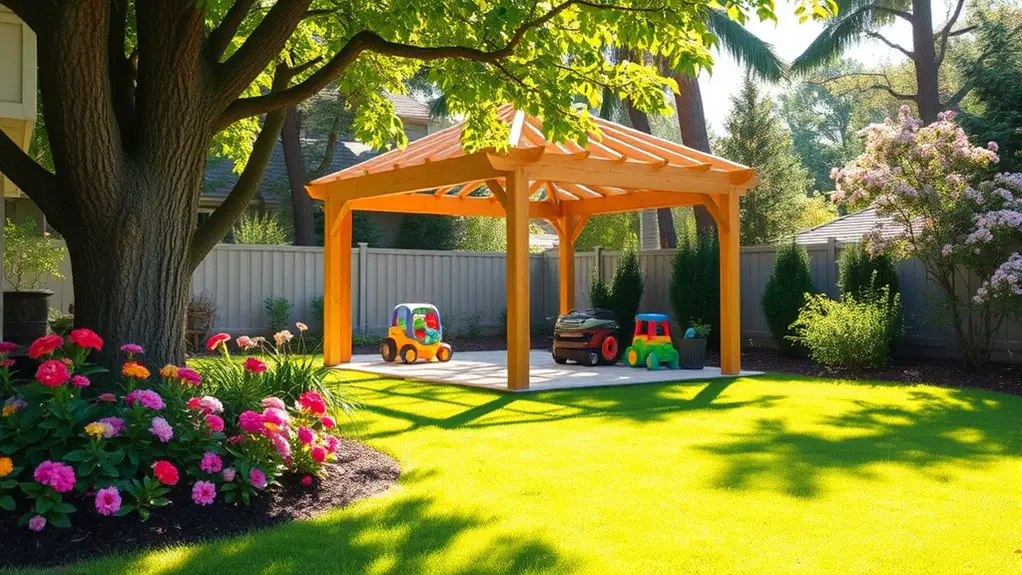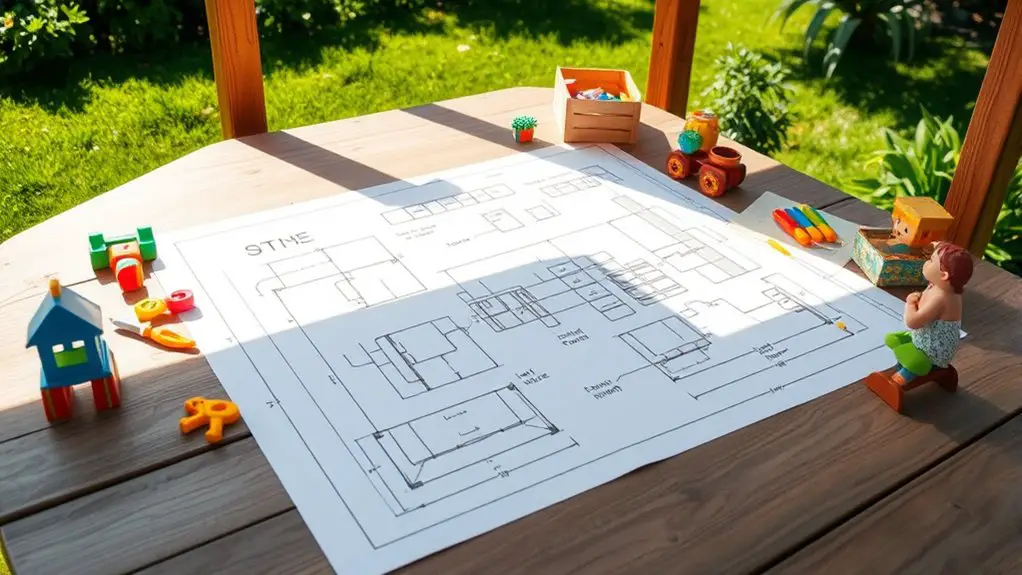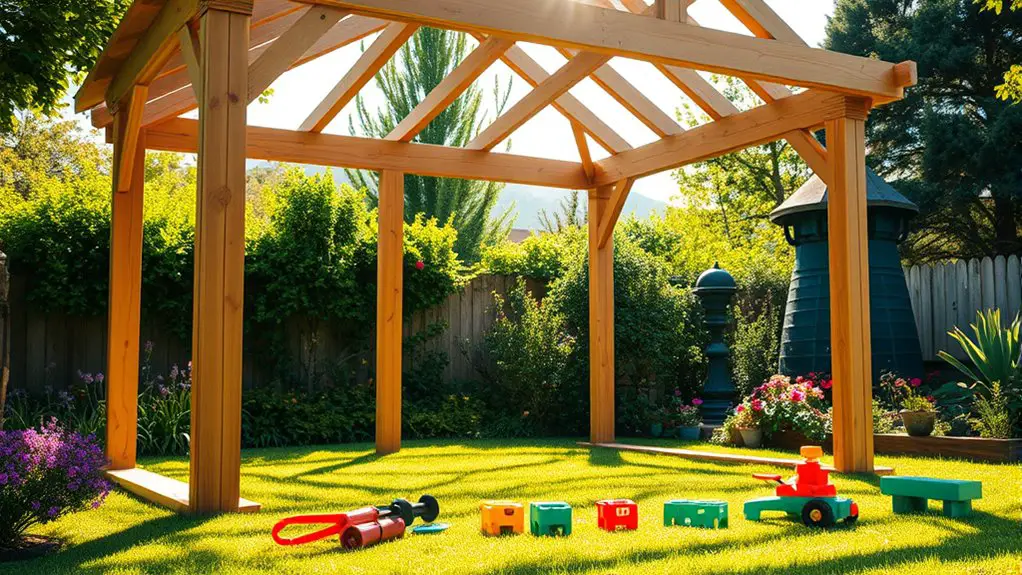To build a gazebo for your children’s outdoor activities, start by choosing a location with good sunlight and shade, ensuring a level and stable ground. Select durable materials like cedar or composite for safety and low maintenance. Design a spacious layout with movable furniture and vibrant colors. Gather essential tools for construction. Finally, don’t forget to include fun features that spark creativity. By following these tips, you’ll create an inviting space for endless adventures. Discover more on enhancing your gazebo experience!
Choosing the Right Location for Your Gazebo

When it comes to choosing the right location for your gazebo, consider three key factors: accessibility, safety, and enjoyment. First, think about sunlight exposure. You want your kids to bask in the warmth without getting scorched. A location with partial shade can offer the perfect balance. Next, ground stability is vital. Make certain the area is level and firm—no sinking or wobbling when the kids run around. A sturdy foundation means fewer worries while they’re playing. Finally, think about how easy it is for kids and parents to get to the gazebo. Make sure it’s close enough to your home for quick supervision, yet far enough to give the kids a sense of freedom. By thoughtfully considering these factors, you’ll create an inviting space that encourages laughter and fun while keeping safety a priority. Additionally, ensure the gazebo is placed in a location that considers sun and shade exposure, as this will enhance the overall comfort and usability for your children. Your gazebo can become a cherished haven for countless adventures!
Selecting Materials for Durability and Safety
While you might be tempted to choose materials based solely on appearance, selecting the right substances for your gazebo is essential for ensuring both durability and safety. You want a structure that withstands the elements while providing a fun, secure environment for your kids to play.
Consider these key materials:
- Cedar or redwood: Naturally resistant to rot and pests.
- Pressure-treated lumber: Offers longevity, perfect for outdoor use.
- Composite materials: Low maintenance and weather resistant options that won’t warp or splinter.
- Child safe finishes: Non-toxic sealants and paints that keep your children safe while enhancing the gazebo’s appearance. Additionally, selecting materials with durability and weather resistance can further enhance the gazebo’s lifespan and functionality.
Designing the Gazebo: Size and Layout Considerations

Designing a gazebo for children’s activities requires careful thought about size and layout—after all, you want to create a space that’s both functional and inviting. Start by considering the number of children who’ll use it; a larger gazebo allows for games and group activities, while a cozy space promotes intimate gatherings.
Think about layout flexibility, too—incorporating movable furniture can transform the area for various activities. Use vibrant colors and playful shapes to enhance gazebo aesthetics, drawing kids in and sparking their imaginations.
Ensure there’s enough open space for play, but also cozy nooks for reading or art projects. By striking the right balance between size and layout, you’ll create a versatile haven that encourages creativity and exploration. Ultimately, your gazebo will be a cherished outdoor retreat, allowing children the freedom to play, learn, and grow in a safe, enchanting environment. Additionally, a well-designed gazebo can increase property value and attract potential buyers, making it a worthwhile investment for families.
Essential Tools and Equipment for Construction
Building a gazebo for children’s activities is an exciting project that requires the right tools and equipment to guarantee a smooth construction process. To ascertain both efficiency and safety, you’ll want to gather essential tool types and prioritize equipment safety. Here’s a handy list to get you started:
- Power Drill: For quick and easy assembly, making holes and driving screws.
- Circular Saw: Ideal for cutting wood with precision and speed.
- Level: Confirms your structure is straight and stable, crucial for safety.
- Safety Gear: Includes goggles and gloves to protect yourself during the build.
Additionally, ensuring the ground levelness is vital for stability and safety in your gazebo construction.
With these tools, you’ll not only enjoy the freedom of crafting your gazebo but also create a safe environment for children’s outdoor fun. Remember, investing in quality equipment can make all the difference in your construction experience!
Step-by-Step Guide to Building the Gazebo

Ready to bring your gazebo vision to life? First, you’ll need to gather the right materials to guarantee a sturdy and beautiful structure. Once you’ve got everything, we’ll walk you through the assembly process step-by-step, making it easier than ever to create a fun space for children’s activities. Additionally, ensure your gazebo has a strong foundation to provide safety and stability for all outdoor play.
Materials Needed for Construction
Creating a cozy gazebo for children’s activities requires a thoughtful selection of materials that guarantee both safety and durability. You’ll want to choose wood types known for their weather resistance, ensuring your gazebo withstands the elements while providing a fun retreat for kids.
Here’s a list of essential materials you’ll need:
- Pressure-treated lumber: For structural integrity and longevity.
- Cedar or redwood: Naturally resistant to decay and insects.
- Weatherproof screws and nails: To secure your construction reliably.
- Outdoor sealant or stain: To enhance durability and protect against moisture.
Assembly Process Overview
When it comes to assembling your gazebo, following a clear, step-by-step guide can make all the difference in ensuring a successful build. Start by laying out all your materials and familiarizing yourself with the assembly techniques. This not only saves time but also aligns with your project timeline. Begin with the base, securing each post firmly, then move to the roof framework. Be sure to double-check your measurements to maintain balance and stability. As you progress, invite your children to help—this adds joy and ownership to their outdoor space. Finally, finish with your chosen roofing material and decorative touches. With patience and attention to detail, you’ll create a beautiful gazebo that inspires countless outdoor adventures!
Adding Fun Features for Kids’ Activities
To make your gazebo a true destination for children’s activities, consider incorporating features that spark imagination and creativity. By adding playful decorations and interactive elements, you can transform this space into a vibrant hub for fun. Here are some ideas to get you started:
- Chalkboard walls: Let kids express their artistic side with a space to draw and write.
- Nature-themed murals: Encourage exploration of the outdoors with colorful designs of trees, animals, and landscapes.
- Hanging games: Install elements like ring toss or bean bag targets for interactive play.
- Mood lighting: Use string lights or lanterns to create an enchanting atmosphere for evening activities.
Additionally, consider the gazebo’s role in enhancing outdoor comfort, as it provides a shaded area for kids to play even on sunny days. These features not only keep kids engaged but also promote imaginative play, making your gazebo a cherished spot for outdoor adventures. Embrace creativity and watch as their spirits soar!
Maintaining Your Gazebo for Longevity and Safety
While it might be tempting to overlook maintenance in the excitement of play, keeping your gazebo in top shape is vital for both safety and longevity. Regular inspections can catch small issues before they evolve into costly repairs or safety hazards. Check for loose boards, rust on metal parts, and signs of wear on the roof.
Weather protection is important—consider applying a weather-resistant sealant to wooden structures to fend off moisture and UV damage. Regularly clean gutters and downspouts to prevent water from pooling around your gazebo, which can lead to structural damage. Additionally, regular inspections are essential for identifying any damage or wear and tear that could compromise safety.
Encourage kids to treat the space with respect; explain that a well-maintained gazebo guarantees endless fun for everyone. By investing a little time in upkeep, you’re not just enhancing safety—you’re extending the life of your beloved outdoor retreat. Enjoy the freedom of worry-free play, knowing your gazebo stands strong for many adventures to come.
Frequently Asked Questions
What Permits Are Needed to Build a Gazebo in My Backyard?
Before you plunge into your gazebo dreams, check your local regulations. You’ll need permits that align with construction guidelines. Steering through this maze guarantees your backyard oasis becomes a reality, free from legal storms.
How Can I Ensure My Gazebo Is Kid-Friendly and Safe?
To guarantee your gazebo’s kid-friendly and safe, choose non-toxic materials and smooth finishes. Incorporate child safety features like rounded edges and secure railings. This way, you’ll create a fun, worry-free space for everyone.
What Are the Best Types of Flooring for a Children’s Gazebo?
For a children’s gazebo, consider wooden decking for its natural aesthetic and warmth. Alternatively, rubber tiles offer a cushioned, slip-resistant surface, ensuring safety during play. Your choice will enhance both fun and freedom for kids!
How Can I Decorate the Gazebo for Kids’ Activities?
Imagine vibrant colors dancing in the sunlight! You can decorate the gazebo with colorful themes like rainbows or jungles, adding fun accessories like bean bags, fairy lights, and chalkboards to spark creativity and joy for kids.
Are There Specific Design Styles That Appeal to Children?
When considering design styles that appeal to children, think playful themes with vibrant colors. Incorporating elements like whimsical shapes and interactive features can spark their imagination, making the space feel inviting and full of adventure.

